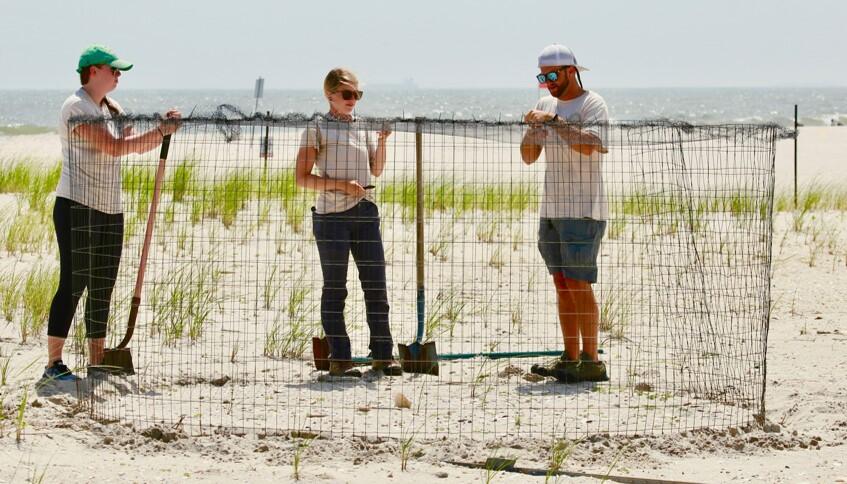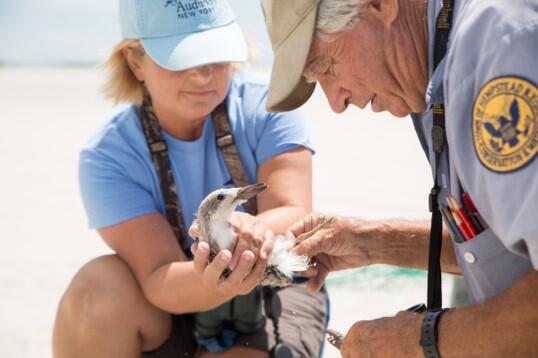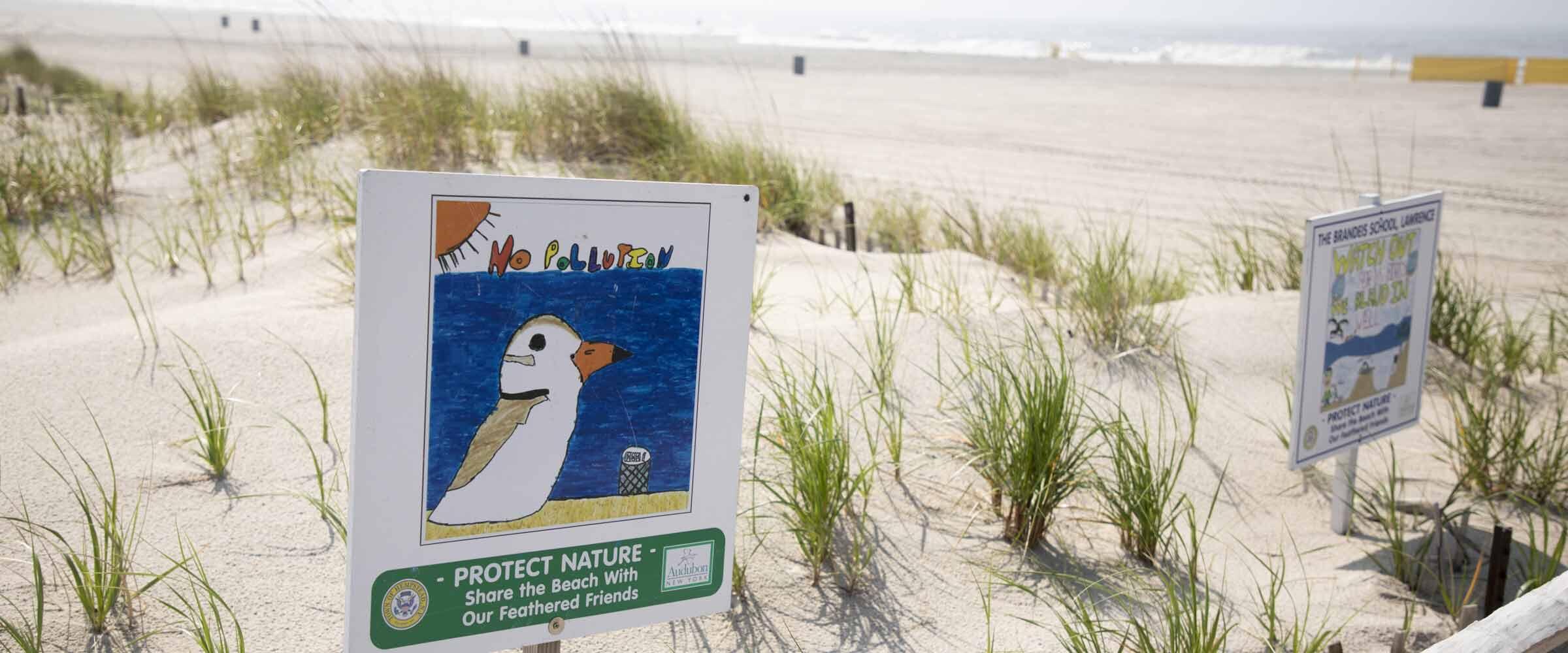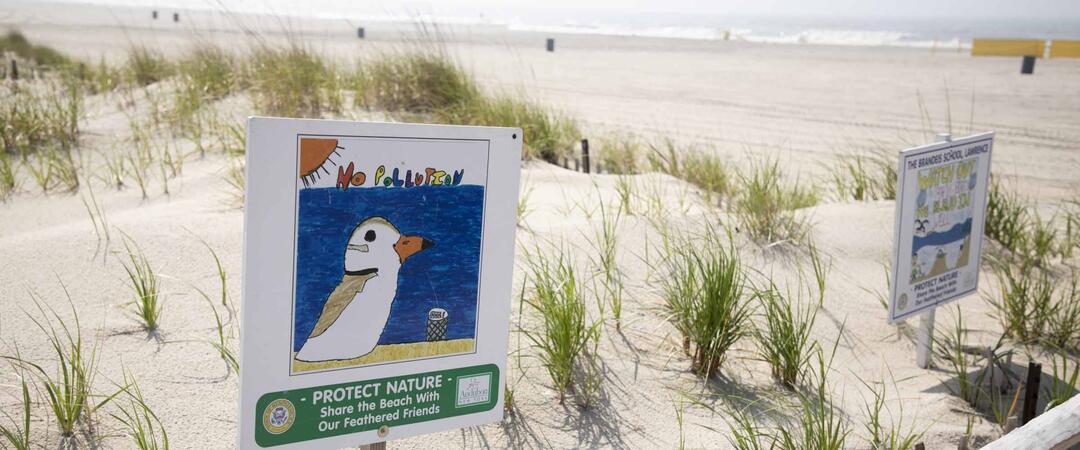Looking out across the beautiful Town of Hempstead beaches on a sunny day in July, it’s hard to believe that a space with so much human recreation can sustain a bustling population of migrating and nesting shorebirds.
Located on the south shore of Long Island, the Town of Hempstead manages a three mile stretch of beach from Jones Inlet to the east, to the City of Long Beach to the west.
Thanks to nearly five decades of dedicated efforts to make their entire shoreline a place where vulnerable birds can thrive, Audubon is proud to present the Town of Hempstead with our first-ever Share the Shore Award!
Your town or city can "Share the Shore" with birds too! Ask them to join our #ShareTheShore movement here.
Let's take a look back at some of the amazing work led by town officials and local volunteers.
1973 | Town of Hempstead begins dune restoration and management program
The Town began to grow the dunes by adding sand, strategically placing snow fencing, and planting American beach grass.
Late 1970s | Town of Hempstead begins monitoring shorebird species on local beaches
The Town of Hempstead began participating in the New York State Department of Environmental Conservation’s (DEC) colonial waterbird surveys. This included counts of nesting terns and skimmers.
1986 | Piping Plover pair counts begin
With the Piping Plover being established as a federally threatened species in 1986, the Town began to survey nesting pairs of Piping Plovers on their beaches.

Early 1990s | Town of Hempstead begins expanding protection methods for endangered species
Piping Plover nest exclosures were utilized to protect nests. Use of string fencing began to protect nesting areas for plovers, terns and skimmers. Beach management practices to prevent erosion included installation of winter snow fencing for sand accumulation, then using heavy equipment to spread accumulated sand in late February. This effort set the early foundation for a robust shorebird habitat management effort to form in the following decade.
Mid 1990s | Colonial Waterbird banding begins, increased management for fireworks season
In order to host 4th of July fireworks displays, the Town was required to coordinate with USFWS to create a plan to protect federally threatened Piping Plovers. This planning resulted in increased management activities for plovers and terns on Town beaches. Also during this time period, the highly productive area known as “The Sanctuary” began to form as a result of winter snow fencing that was not removed one year, and formed a dune island that eventually became surrounded by ephemeral pools.
1996 | Town of Hempstead begins use of GPS and GIS technology to map plover nests towards research, management, and communication efforts
The Town purchased a commercial grade GPS unit and a GIS software license. The GPS unit was used to collect data on shorebird nest locations, string fencing locations, and other features. GIS software was utilized to create maps for long-term shorebird datasets, and as a visual communication tool for sharing nesting locations with other departments and agencies on the beach. The Town staff also supported neighboring NYS Parks at Jones Beach to map their string fence and Piping Plover nest locations with the Town’s GPS units and GIS software.
1997 | Piping Plover productivity counts begin and first American Oystercatcher pair nests on town beaches
This year, more focused Piping Plover observations and monitoring occurred, with the first productivity estimates reported. Also notable this year, the first American Oystercatcher nest was observed on Town beaches. While there had been oystercatchers nesting observed in the marshes since the early 90s, this was the first nest on the Town’s ocean beaches.
1997 | South Shore Audubon Society partners with Town of Hempstead
South Shore Audubon Society, a local Audubon chapter, started providing volunteers to help with monitoring efforts and repairing string fencing.

1999 | Town beaches are recognized as an Important Bird Area
Audubon New York recognized Town of Hempstead beaches including Point Lookout, Lido Beach, and Sands Beach as an Important Bird Area because they are critical to nesting Piping Plovers, Least Terns, Black Skimmers, and American Oystercatchers and a large variety of other shorebirds like the Red Knot, Semipalmated Sandpipers, Least Sandpipers, and Semipalmated Plovers as well as waterfowl. This barrier beach also helps protect the south shore of Long Island and its residents from coastal storms.
2000s | The Town builds staff in order to expand its environmental program to focus on nesting shorebirds
During this decade from 2000 to 2010, the Town began to build full time staff dedicated to shorebird monitoring, and added more seasonal part time staff, in order to meet monitoring needs. Schedules were expanded to seven days per week. The Town increased efforts to work with local colleges to hire summer staff for shorebird monitoring programs. By the late 2000s, the Town further increased staff, allowing for dawn-to-dusk coverage, seven days per week. This helped to capture better monitoring data, as well as prevent off-hour disturbances. The staff-building that occurred during this decade allowed the Town to start more research-focused projects in the following decade.
2002 | Shorebird habitat restoration evolves
The Town’s beach management program that began in 1973 began to evolve around this time. The original focus was centered around beach erosion and accretion. What became clear was that the devegetation in certain areas fostered nesting habitat for Piping Plovers and colonial nesting birds. Efforts to monitor the changes in habitat topography began, and strategic wintertime habitat management efforts ramped up.
2005 | Highest number of Piping Plover chicks fledge
Increased monitoring and staff has paid off, with 2005 logging the highest number of chicks fledged from the Town’s sites to date, with 33 chicks fledged from 17 pairs.
2006 | Focus on ephemeral pools helps create more foraging habitat, leading to faster fledge rates
The Town began more detailed monitoring of the beach topography, looking at beach elevations with a new survey-grade GPS unit that gave vertical readings at sub-centimeter accuracy. This allowed the Town to begin to better maintain and create ephemeral pools for shorebird foraging, which allows for faster fledge rates.
Late 2000s | Increased staff and seven day per week dawn to dusk coverage helps prevent disturbance
The Town continued to increase the summer staff, and with more summer staff they were able to stagger shifts and provide seven day per week monitoring starting at 6am and ending at 8pm. This helped to capture better monitoring data, as well as prevent off-hour disturbances such as people inside the string fencing and unleashed dogs.
2011 and 2012 | Hurricane Irene and Superstorm Sandy bring the community together
Hurricane Irene strikes Long Island, flooding the basements of residents on the South Shore. In 2012, the South Shore was decimated by Superstorm Sandy, this time forcing residents out of their homes for months, and leaving them with questions for the future. Understanding how important barrier beaches are for protection, the residents of Point Lookout, Lido Beach and other surrounding coastal communities worked diligently to build back better for the future by rebuilding dunes, which in turn supports the wildlife that inhabit them. This time period resulted in multiple community engagement programs including grass plantings, beach cleanups, and outreach tours, which continue to current day.

2012 | Black Skimmer banding begins
This was the first year that Black Skimmer adults were banded with metal federal bird bands.
2013 | Town works with Nassau County for improved habitat restoration in historical nesting areas
Shared resources resulted in a larger scale restoration of “The Sanctuary” nesting area. The Town utilized GPS, aerial photography, and historical data sets to improve degrading habitat throughout “The Sanctuary” as well as many of the other nesting sites. The results have brought an increased number of nesting birds since then, including the largest Black Skimmer colony in New York!
2014 | Use of camera traps for predator monitoring
The Town began the use of infrared camera traps to monitor for predators at Piping Plover nest sites.
2014 | Audubon New York and Town of Hempstead partner for its Share the Shore outreach initiatives, engaging thousands of beachgoers
Partnering with Audubon New York, and local school Districts such as the Brandeis school in Lawrence, the Town and Audubon began an art contest with school children to bring colorful and informative signs to the nesting sites, to supplement standard government issued signage. The result was better engagement with the public, and an incredibly well-educated generation of young bird stewards!. In addition, Audubon staff sponsored table sessions at Town beaches to help promote stewardship, asking beachgoers to learn about shorebirds and pledge to “Be a Good Egg.” Since 2014, thousands of signatures have been collected at Town sites.
In addition, the Town started working with Audubon to focus more closely on the quickly increasing American Oystercatcher nesting pairs on their beaches. Audubon provided trained summer staff to supplement the Town’s efforts to collect nest data, monitor for renests, and chick productivity.
2015 | Black Skimmer banding results in close 1,000 birds monitored
This year, working with NYS DEC, the Town began to band Black Skimmer chicks with yellow field-readable color bands, using a colony round-up method, resulting in larger numbers of chicks being banded in a short period of time. This has resulted in close to 1,000 skimmers being banded at the Town’s site since 2015, with 700 of those birds having the field-readable color bands.
2016 | Plover Camera deployed in partnership with SUNY Stony Brook to track chicks after hatching
Town of Hempstead partnered with SUNY Stony Brook to develop an innovative camera that could be deployed to the beaches with an attempt to track plover chicks after hatching and document chick loss in real time with video evidence. The camera is high resolution with infrared illuminators for night time viewing, and can be accessed remotely with the ability to pan, zoom, and create patrol routes. The setup has solar panels with a battery backup, so it can be deployed anywhere on the beach without the need for a direct power or network connection.
2016 | Town of Hempstead expands internship programs to support monitoring efforts
With colleges increasing their focus on experiential learning requirements for students, the Town began to partner with high schools and colleges to offer unpaid internships focused on shorebird management such as Long Beach High School, Hofstra University, SUNY Stony Brook, Molloy College, Adelphi University, University of Maryland, Coastal Carolina University, University of Delaware, and others.
2018 - 2019 | GPS transmitters deployed on Black Skimmers to learn about foraging habitat
In partnership with Oklahoma University and funded by Nassau County Soil & Water Conservation District, GPS transmitters were deployed on 29 black skimmers between 2018 and 2019. The purpose of this study was to better understand skimmer foraging locations on a more local scale, and correlate those locations with long term water quality datasets. In addition, a diet characterization study was initiated to better understand the important forage species for skimmers and their chicks. This data will better inform managers on important foraging habitats, and what the characteristics of those habitats look like, so they can be preserved and maintained.
2019 | Management goes online: Begins use of ArcOnline for Shorebird Map Communications and use of NestStory - Online Data Collection Platform
The Town began to use the NestStory platform with great success and collaboration with the program’s founder, Jim Verhagen. In addition, the Town began to use ArcOnline, which helped transition our communication efforts to a digital platform, with on-the-fly updates. Rather than paper distribution of the plover maps, everyone in the field had access to the latest plover nesting developments and management actions.
2020 | COVID-19 results in largest number of plover pairs and skimmer adults in over a decade
Little did anyone expect the Town’s efforts in 2019 to move all data collection online would be extremely timely in preparation for the unexpected Covid-19 pandemic. Even during a global pandemic, the Town of Hempstead remained dedicated to the protection of the ecosystem, while promoting safe outdoor recreation during a very difficult time for residents. The result was the largest number of Piping Plover pairs and Black Skimmer adults at the colony in over a decade.
YOUR TOWN OR CITY CAN FOLLOW IN THEIR FOOTSTEPS!
Anyone can follow in the Town of Hempstead's footsteps by addressing our six essential "Share the Shore" Award criteria. Just let your local decisionmakers know!
We’ll work with your community to help you:
- Actively manage critical beach habitat
- Launch exciting new programs for volunteers and/or launch paid positions for local youth
- Share positive public messages about shorebirds
- Partner with other local organizations, Audubon chapters, scout troops, and more to help birds
- Seek out feedback from experts
- Innovate and look for new opportunities, especially those related to building stronger, healthier coastlines that can stand up to sea level rise





